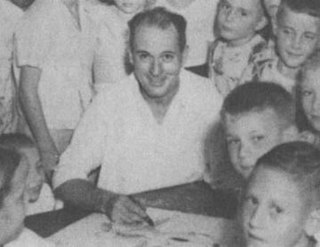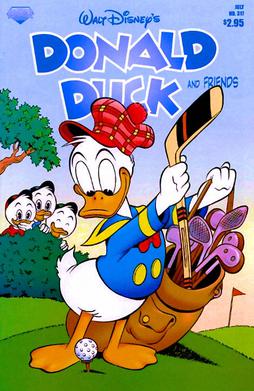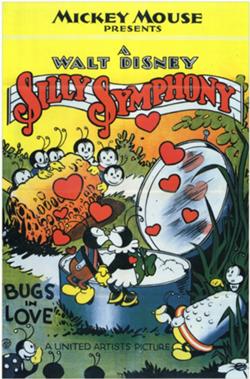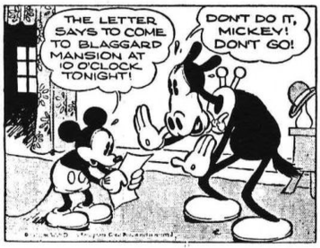Related Research Articles

Charles Alfred "Al" Taliaferro, was an American Disney comics artist who produced Disney comic strips for King Features Syndicate. Taliaferro is best known for his work on the Donald Duck comic strip. Many of his strips were written by Bob Karp.

Theodore H. Osborne was an American writer of comics, radio shows and animated films, remembered for his contributions to the creation and refinement, during the 1930s, of Walt Disney cartoon characters.

The Duck family is a fictional family of cartoon ducks related to Disney character Donald Duck. The family is also related to the Coot, Goose, and Gander families, as well as the Scottish Clan McDuck. Besides Donald, the best-known members of the Duck family are Huey, Dewey, and Louie, Donald's triplet nephews.
Disney comics are comic books and comic strips featuring characters created by the Walt Disney Company, including Mickey Mouse, Donald Duck and Scrooge McDuck.
Bucky Bug is a beetle who appears in Disney comics. He first appeared in the Silly Symphony Sunday comic strip, and later appeared as a regular feature in the comic book Walt Disney's Comics and Stories.

Donald Duck, also known as Donald Duck and Friends, is an American Disney comic book series starring the character Donald Duck and published by various publishers from October 1942 to June 2017. As with many early Disney comics titles, Donald Duck began as individual issues of Dell Comics' Four Color one-shots series. It was published as its own regular series in November 1952, starting with issue #26.

Donald's Nephews is a 1938 Donald Duck animated cartoon which features Donald being visited by his three nephews, Huey, Dewey, and Louie. This cartoon is Huey, Dewey, and Louie's first appearance in animation. Al Taliaferro, the artist for the Silly Symphony comic strip, proposed the idea for the film, so that the studio would have duck counterparts to Morty and Ferdie Fieldmouse, the nephews of Mickey Mouse. The Walt Disney Productions Story Dept. on February 5, 1937, sent Taliaferro a memo recognizing him as the source of the idea for the planned short.
Donald Duck, a cartoon character created by the Walt Disney Company, is today the star of dozens of comic-book and comic-strip stories published each month around the world. In many European countries, Donald is considered the lead character in Disney comics, more important and beloved than Mickey Mouse.
Robert Louis Karp (1911–1975) was an American comics writer.

Little Hiawatha is a 1937 animated cartoon produced by Walt Disney Productions, inspired by the poem The Song of Hiawatha by Henry Wadsworth Longfellow. It does not appear to have historical correlation to legendary Mohawk leader and peacemaker Hiawatha. It is the last Silly Symphonies short to be released by United Artists.

Bugs in Love is a Silly Symphonies animated Disney short film. It was released in 1932, and was the final Symphony to be shot with black-and-white film.

Silly Symphonies: The Complete Disney Classics is a book series which reprints Walt Disney's Silly Symphony Sunday comic strip, drawn by several different Disney artists from 1932 to 1945. The strip was published by King Features Syndicate. The strip often introduced new Disney characters to the public, including its first comic character, Bucky Bug. The series was published by The Library of American Comics from 2016 to 2019.
Donald Duck: The Complete Sunday Comics is a series of hardcover books collecting the complete run of Disney's Donald Duck Sunday newspaper comic strip. Drawn by the American comic artist Al Taliaferro, it starts off with the first of Donald Duck's own Sunday strip page from 10 December 1939, after he had first been introduced in the successful Silly Symphony Sunday strip feature as well as in his own daily newspaper strip since 1938. The publisher behind the project is IDW Publishing and their imprint (subdivision), The Library of American Comics. The first book of the series was released in March 2016.
Donald Duck: The Complete Daily Newspaper Comics is a series of hardcover books collecting the complete run of the Disney Donald Duck comic strip, a daily newspaper comic strip drawn by the American comic artist Al Taliaferro. The comic strip debuted on February 7, 1938, and within eight weeks became the fastest growing syndicated comic strip worldwide. The publisher behind the project is IDW Publishing and their imprint, The Library of American Comics. The first book of the series was released on September 2, 2015.
Walt Disney's Treasury of Classic Tales is a series of hardcover books that collects the Sunday comic strips of Walt Disney's Treasury of Classic Tales, an umbrella title for comic strips which were drawn by several different Disney artists during the period of the early 1950s to the mid-1980s. The Treasury of Classic Tales comic strips were used by Walt Disney Studios to introduce current movie characters into comic adaptations for the public. The books are being published by IDW Publishing's imprint, The Library of American Comics. The first book of the series was released in November 2016.

Mickey Mouse is an American newspaper comic strip by the Walt Disney Company featuring Mickey Mouse and is the first published example of Disney comics. The strip debuted on January 13, 1930, and ran until July 29, 1995. It was syndicated by King Features Syndicate until 1990, when Disney switched to Creators Syndicate, which distributed the strip until 2014.

Mickey Mouse Magazine is an American Disney comics publication that preceded the popular 1940 anthology comic book Walt Disney's Comics and Stories. There were three versions of the title – two promotional giveaway magazines published from 1933 to 1935, and a newsstand magazine published from 1935 to 1940. The publication gradually evolved from a 16-page booklet of illustrated text stories and single-page comic panels into a 64-page comic book featuring reprints of the Mickey Mouse and Donald Duck comic strips.
Silly Symphony is a weekly Disney comic strip that debuted on January 10, 1932, as a topper for the Mickey Mouse strip's Sunday page. The strip featured adaptations of Walt Disney's popular short film series, Silly Symphony, which released 75 cartoons from 1929 to 1939, as well as other cartoons and animated films. The comic strip outlived its parent series by six years, ending on October 7, 1945.
Uncle Remus and His Tales of Br'er Rabbit is an American Disney comic strip that ran on Sundays from October 14, 1945, to December 31, 1972. It first appeared as a topper strip for the Mickey Mouse Sunday page, but after the first few years, almost always appeared on its own. The strip replaced the 1932-1945 Silly Symphony strip, which had spent its final year on gag strips featuring Panchito from The Three Caballeros.
Donald Duck and Other Adventures, also known as Paperino giornale, is a 1937–40 weekly Italian Disney comics magazine published by Mondadori. The comic was launched by Federico Pedrocchi, Mondadori's art director, as a companion to the existing weekly Topolino magazine. Paperino published 149 issues from 30 December 1937 to 26 October 1940, at which point it was merged with Topolino.
References
- 1 2 3 4 5 6 7 8 9 10 11 12 Holtz, Allan (2012). American Newspaper Comics: An Encyclopedic Reference Guide. Ann Arbor: The University of Michigan Press. p. 130. ISBN 9780472117567.
- 1 2 3 Gerstein, David (2015). Donald Duck: The Complete Daily Newspaper Comics . The Library of American Comics. p. 4. ISBN 978-1631403354.
- ↑ Kaufman, J.B. (2016). Walt Disney's Silly Symphonies Volume 2: The Complete Disney Classics. San Diego, CA: IDW Publishing. ISBN 9781631408045.
- 1 2 3 4 5 6 7 8 9 10 Knudde, Kjell (1994). "Al Taliaferro". Lambiek Comiclopedia. Retrieved December 9, 2018.
- ↑ Kaufman, J.B.; Gerstein, David (2024). Walt Disney's Donald Duck: The Ultimate History. Taschen. p. 94. ISBN 978-3-8365-5280-6.
- 1 2 Becattini, Alberto (2016). Disney Comics: The Whole Story. Theme Park Press. p. 23. ISBN 978-1683900177.
- ↑ Thomas Andrae, "The Legacy of Al Taliaferro," in Disney's Four Color Adventures vol. 1 (2011).
- ↑ "Forbidden Fruit". Inducks.org. Retrieved 2 July 2019.
- ↑ "Just In Time For Dinner". Inducks.org. Retrieved 2 July 2019.
- ↑ "Donald Duck Settles a Grudge". Inducks.org. Retrieved 2 July 2019.
- ↑ "Donald makes a hit". Inducks.org. Retrieved 2 July 2019.
- ↑ "Donald Duck 43-09-27". Inducks.org. Retrieved 2 July 2019.
- ↑ "Socrates M. Gosling". Inducks.org. Retrieved 2 July 2019.
- ↑ "Donald Duck 51-02-13". Inducks.org. Retrieved 2 July 2019.
- ↑ "Donald Duck 51-08-07". Inducks.org. Retrieved 2 July 2019.
- ↑ "Donald Duck 61-09-25". Inducks.org. Retrieved 2 July 2019.
- ↑ "Donald Duck 71-12-06". Inducks.org. Retrieved 2 July 2019.
- ↑ "Donald Duck 90-08-02". Inducks.org. Retrieved 29 July 2019.
- ↑ "Donald Duck 90-08-20". Inducks.org. Retrieved 29 July 2019.
- ↑ "The Big Little Book Club: Whitman Publishing". BigLittleBooks.com. Retrieved 30 July 2019.
- ↑ "One-Shots (Series 1) #4". Comic Vine . Retrieved 24 July 2022.